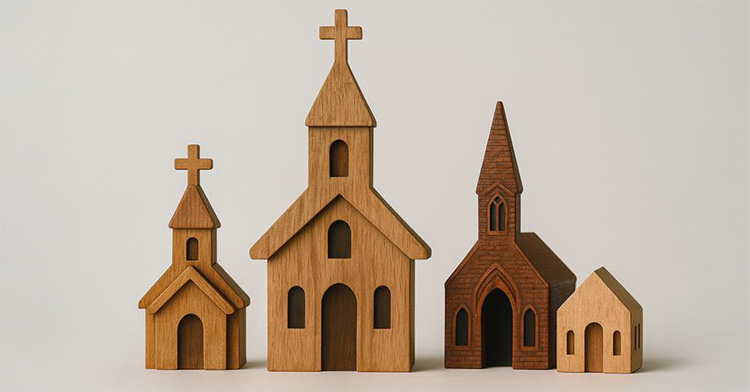Where are all the young people? It’s a question that absorbs the leaders of mainline institutions, as research continues to reveal the millennial generation as one of the least engaged in religious life.
Yet there is a seeming contradiction: research also shows that millennials have a strong sense of faith in God.
So how do Christian institutions connect with that yearning? From my own observations and conversations, it seems that the most effective “programs” combine the traditional with the unconventional.
These range from Theology on Tap gatherings to coffeehouses that host spoken-word artists to urban community gardens -- all creative ways for churches to connect with millennials and digital natives.
But how do churches come up with these plans and ideas?
At a recent weekend workshop, I learned how design methods can offer an exciting way for congregations and institutions to work with their members and prospective members -- including those turned-off young people -- to create churches that are meaningful, beautiful and faithful.
The consultation weekend was led by designer Bethany Stolle, who described design as being “more about the questions than the products, more about process -- participatory, generative, action-oriented, abductive, empathetic and locally driven.”
It’s a process that she likens to “building the sandbox and defining the borders.” The sandbox sets parameters, but it is not limiting; it is the sand that invites imagination and creativity and possibilities. It invites people to play, experiment and embrace failing and starting over again and again.
This is a shift from the corporate model that has influenced many church structures. The corporate model tends to rely on top-down and linear hierarchies and decision-making processes to organize the work.
It came of age during the early ’80s as megachurches began to sprout up. These organizations sought feedback from members, often relying on automated or paper surveys with limited response options.
By contrast, the design model emphasizes empathy, flattened hierarchies and networked decision making.
Design thinking uses a prototype -- something tangible to look at and work with -- that invites people to the table.
For instance, rather than asking a group multiple-choice questions about worship services, a design-method leader might put up sheets of newsprint labeled with words related to liturgy, such as “contemplative,” “prayer” or “traditional,” and invite participants to stick on images -- anything from a dog in the park to a crying baby -- that they associate with those words. The visuals serve to prompt a fresh conversation about topics that may have become rote.
Visuals, including diagrams and sketches, can supplement or even replace spreadsheets, specifications and other documents, writes the founder and director of Austin Center for Design, Jon Kolko, in the Harvard Business Review.
The visuals “add a fluid dimension to the exploration of complexity, allowing for nonlinear thought when tackling nonlinear problems,” he writes.
The design approach encourages social risk taking, such as voicing an idea that is not fully formed, and is tolerant of failure, viewing it as a natural part of the creative process, Kolko writes. Without room for failure, there is not much chance for growth or discovery.
Stolle used this kind of process when conducting interviews with young people about their religious experience, she said.
The participants filled out journals, used Rorschach-type images to describe their ideal churches and hosted Stolle in their homes. These activities profoundly connected Stolle to her interviewees, and many of the participants expressed appreciation for being heard and being given the space to reflect deeply on their religious needs and experiences.
What I love about this approach is the potential it offers churches not only to create programs for outreach to young adults but also to shape their communities’ attitudes -- and posture -- toward people’s lived experiences in this cultural landscape.
The process doesn’t mean that anything goes, of course. The sandbox of design-centric methods is wide, offering us many ways to be creative and imaginative while remaining rooted in our traditions, theologies and identities.
At Church of the Pilgrims in Washington, D.C., for example, a design approach encourages improvisation in worship, within the limits of tradition.
“We have stations set up for kids around the sanctuary, which means kids are cruising around all the time. We have time for testimony. We improv the Prayer of Great Thanksgiving. We move around during worship,” writes the Rev. Ashley Goff in her blog God of the Sparrow.
“But …,” she explains “we sit in our pews. We still sing when the order of worship says to sing. We don’t call and respond to the preacher or liturgist.”
Research shows that millennials are hungry for religious experience that is meaningful and meets them where they are in their lives. For churches to be provocative and compelling spaces for them to encounter God, it is not enough to repackage traditional programs.
Design methods make space for that human connection, both in the final product and in the creative process. It is a way to be faithful, and to be an active part of something much more beautiful.
How can churches implement design thinking? Consider these suggestions:
- Create a focus group or “play session” around a question like, “What new mission could we establish?” or “What do our children need?” or “How can we care for our aging members?” Tangible activities such as role playing, visualization or newsprint mapping can spark conversation and ideas, which staff and leaders can then use to shape new programs.
- Have congregational leaders spend time creating and talking about their ideal church prototype. “The point is to externalize it, and not just use words, which are prone to misunderstanding or assumptions of understanding,” Stolle said. “By externalizing, diagramming, storyboarding and visualizing, I think people make fewer assumptions that they know what the other person thinks. Or those assumptions become apparent as people describe the same picture in different ways. It’s the difference between reading the Bible in text and telling the Bible story through a stained-glass window.”
- Invite others into these conversations -- other churches and even other denominations and faith communities, particularly those that are experimenting -- not for the sake of totally revamping your church, but in order to see the possibilities.
- Invite a design consultant to create a process by which you can discover how your church looks and operates during a Sunday morning worship service.

















